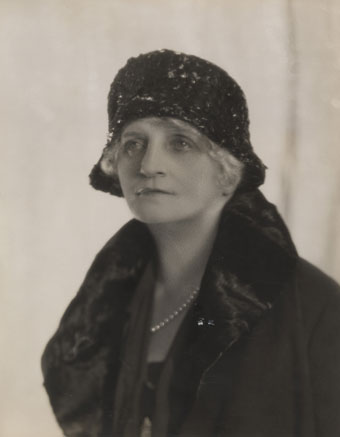Many of the collections in the IET Archives contain photographs and many of these photographs have subject matter that is non-technical. However, what people might not expect is a small but significant number of photographs of ‘famous’ people taken by noted society photographers of the 1930s such as the photograph above of Amy Johnson taken by John Capstack.
Several of these photographs we cannot use for social media purposes as they are still within copyright. If we know the name of a photographer, and the photograph was taken before 1 June 1957, then copyright will only expire 70 years after the death of an author. That means that some of these photographs taken in the 1930s will remain in copyright until the 2020s, 2030s and even 2040s depending on the date of death of the individual photographer.
There are however, some of these society photographs that we can reproduce here, including those were we have the permission of the copyright holder, and those works which have been deemed to be orphan works. An orphan work is one where despite extensive efforts to trace the copyright owner, no known copyright owner can be traced.
Two of the better known photographers whose works are held in the archive collection are John Capstack and Madame Yevonde.
John Capstack (1881-?)
John Capstack was born in Accrington in 1881 and eventually moved to Blackpool after being invalided out of WWI with tuberculosis. For around 30 years Capstack had a studio on the sea front at Blackpool and during this time he took many ‘glamorous’ photographs of well-known individuals such as the actresses Peggy Ashcroft in the 1920s and Anna May Wong in 1933.
There was a touring exhibition of Capstack’s work in the late 1990s and in the Birmingham Post’s commentary on that exhibition it said that Amy Johnson (married name Amy Mollison) had her picture taken by Capstack twice, once in flying gear and once in a Gypsy Moth after her solo flight to Australia. The portrait of Amy Johnson in flying gear, was used for autographed photographs, and is widely available on the internet for example via the National Portrait Gallery website and the photographic agency Getty Images.
However, the exhibition was not correct that Capstack only took two photographs of Amy Johnson, and their relationship as photographer and sitter appears to have been much stronger. We have three photographs of Amy Johnson taken by Capstack in the archive collections which do not appear to have been known about before. In addition to the photograph above, the two photographs below of Amy Johnson were also taken by Capstack.


We have these photographs because Amy Johnson was a 2-term President of the Women’s Engineering Society (WES) in 1935/36 and 1936/37, whose collection we hold in the archives, and as a consequence there are many Amy Johnson photographs as well as her correspondence in the WES collection.
Yevonde Middleton (1893-1975) known as Madame Yevonde
Yevonde Cumbers Middleton was an English photographer who pioneered the use of colour in portrait photography, and who went by the professional name of Madame Yevonde. After leaving school Yevonde was given a 3-year apprenticeship with the portrait photographer Lallie Charles. With this technical grounding and a gift of £250 from her father she set up her own studio at 92 Victoria Street, London, at the age of 21.
By 1921 Madame Yevonde had become a well-known and respected portrait photographer, and moved to larger premises at 100 Victoria Street. Here she began taking advertising commissions and also photographed many of the leading personalities of the day, including A.A. Milne, Barbara Cartland, Diana Mitford, Louis Mountbatten and Noël Coward.
In the early 1930s, Yevonde began experimenting with colour photography, using the new Vivex colour process from Colour Photography Limited of Willesden. In 1933 Madame Yevonde moved again, this time to 28 Berkeley Square. She began using colour in her advertising work as well as her portraits, and took on other commissions. Yevonde’s most famous work was inspired by a theme party held in March 1935, where guests dressed as Roman and Greek gods and goddesses. At the end of 1939, Colour Photographs Ltd closed and Yevonde returned to working in black and white. She continued working up until her death, just before her 83rd birthday, but is chiefly remembered for her work of the 1930s, which did much to make colour photography respectable.
When Madame Yevonde died in 1975 she left all her remaining negatives, prints, records and copyright to her Assistant Anne Foreshaw. When Anne Foreshaw died in 1986 the entire collection passed to its present owner Lawrence N Hole who runs the Yevonde Portrait Archive. For more information about the archive, including a full biography of Madame Yevonde, its website can be accessed here – Yevonde Portrait Archive
Recently we uncovered three Madame Yevonde photographs in the archive collections that were unknown to the Yevonde Portrait Archive. These photographs were found in the Electrical Association of Women (EAW) collection and were of past Presidents of the EAW. We have supplied digital copies of these images to the Madame Yevonde Portrait Archive and its licensing agency, the Mary Evans Picture Library, who have kindly allowed us to reproduce these photographs below. The first photograph is of Lady Moir (EAW President 1931-1935) taken whilst in office. The second and third photographs are of Dowager Lady Swathling (EAW President 1938-1957) and were taken in February 1950.

© Yevonde Portrait Archive/Mary Evans Picture Library.

© Yevonde Portrait Archive/Mary Evans Picture Library.

© Yevonde Portrait Archive/Mary Evans Picture Library.
To see more photographs in the archive collections by society photographers of the 1930s, such as Dorothy Wilding, these can be viewed at the IET Archive Centre, Savoy Hill House, London, by appointment.

Leave a comment